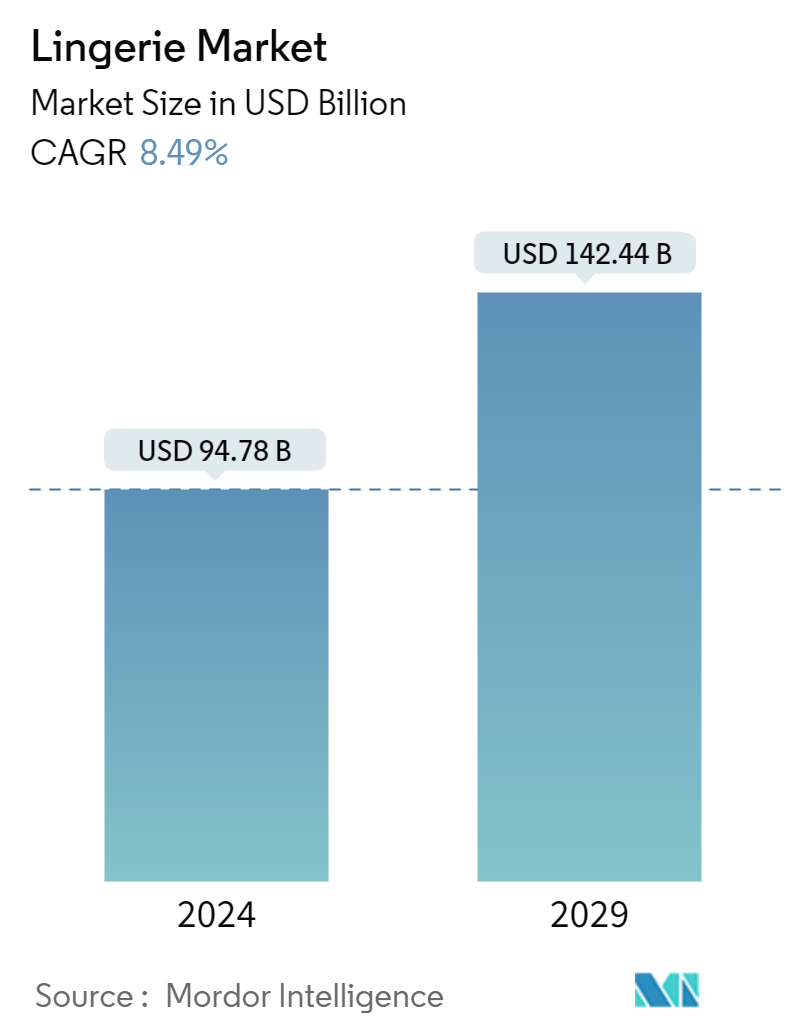Market Size of Lingerie Industry

| Study Period | 2019 - 2029 |
| Market Size (2024) | USD 94.78 Billion |
| Market Size (2029) | USD 142.44 Billion |
| CAGR (2024 - 2029) | 8.49 % |
| Fastest Growing Market | Asia-Pacific |
| Largest Market | Asia Pacific |
| Market Concentration | Low |
Major Players
*Disclaimer: Major Players sorted in no particular order |
Lingerie Market Analysis
The Lingerie Market size is estimated at USD 94.78 billion in 2024, and is expected to reach USD 142.44 billion by 2029, growing at a CAGR of 8.49% during the forecast period (2024-2029).
Consumer behavior towards innerwear lingerie has transformed substantially in recent years, primarily influenced by commercial advertisements, social media, and increased disposable income. As a result, the per capita spending on lingerie globally has increased substantially. Moreover, with the increasing participation of individuals in sports and the rising trend of athleisure, there has been an increase in the demand for intimate wear, which is comfortable and stretchable yet stylish. Furthermore, the emergence of several independent and private-label players has spurred competition through product innovations. Moreover, market players emphasize a structural transformation through digitalization to capture a younger target internationally via social networks. For instance, in 2022, Adidas launched an extensive sports bra collection featuring different new styles across several product franchises to support active women's specific needs better. The company also launched an online bra-fitting service to ensure the correct size for women shoppers and extend its in-store fitting service.
Lingerie Industry Segmentation
Lingerie is a category of women's clothing that includes shapewear, undergarments, and others.
The lingerie market is segmented by product type, distribution channel, and geography. Based on product type, the market is segmented into brassiere, briefs, and other product types. Based on distribution channels, the market is segmented into supermarkets/hypermarkets, specialty stores, online retail stores, and other distribution channels. Based on geography, the market is segmented into North America, Europe, Asia-Pacific, South America, and the Middle East and Africa.
The market sizing has been done in value terms in USD for all the abovementioned segments.
| Product Type | |
| Brassiere | |
| Briefs | |
| Other Product Types |
| Distribution Channel | |
| Supermarkets/Hypermarkets | |
| Specialty Stores | |
| Online Retail Stores | |
| Other Distribution Channels |
| Geography | |||||||||
| |||||||||
| |||||||||
| |||||||||
| |||||||||
|
Lingerie Market Size Summary
The lingerie market is experiencing significant growth, driven by evolving consumer behaviors and trends. The increasing influence of commercial advertisements and social media, coupled with rising disposable incomes, has led to a substantial rise in per capita spending on lingerie globally. The demand for comfortable and stylish intimate wear is further fueled by the growing participation in sports and the popularity of athleisure. The market is characterized by intense competition, with numerous independent and private-label players introducing innovative products. Companies are also embracing digital transformation to reach younger audiences through social networks. Notable initiatives, such as Adidas's launch of a diverse sports bra collection and online bra-fitting services, highlight the industry's focus on catering to specific consumer needs.
The Asia-Pacific region stands out as the largest market for lingerie, propelled by the expansion of e-commerce and increasing disposable incomes. The entry of popular brands into the regional market, along with attractive online discounts, is expected to drive further growth. Brands are also introducing body-inclusive and sustainable lingerie options to appeal to environmentally conscious consumers, particularly millennials and Generation Z. The market is highly fragmented, with local and international players like Hansbrands Inc., Victoria's Secret & Co., and Jockey International Inc. competing for market share. These companies are investing in new materials and design technologies to meet evolving consumer demands, as evidenced by recent product launches from Hanesbrands Inc., Wacoal, and Calvin Klein.
Lingerie Market Size - Table of Contents
-
1. MARKET DYNAMICS
-
1.1 Market Drivers
-
1.1.1 Influence of Endorsements and Aggressive Marketing
-
1.1.2 Inclination Toward Healthy Lifestyle And Athleisure
-
-
1.2 Market Restraints
-
1.2.1 Prevalence of Counterfeit Goods
-
-
1.3 Porter's Five Forces Analysis
-
1.3.1 Threat of New Entrants
-
1.3.2 Bargaining Power of Buyers/Consumers
-
1.3.3 Bargaining Power of Suppliers
-
1.3.4 Threat of Substitute Products
-
1.3.5 Intensity of Competitive Rivalry
-
-
-
2. MARKET SEGMENTATION
-
2.1 Product Type
-
2.1.1 Brassiere
-
2.1.2 Briefs
-
2.1.3 Other Product Types
-
-
2.2 Distribution Channel
-
2.2.1 Supermarkets/Hypermarkets
-
2.2.2 Specialty Stores
-
2.2.3 Online Retail Stores
-
2.2.4 Other Distribution Channels
-
-
2.3 Geography
-
2.3.1 North America
-
2.3.1.1 United States
-
2.3.1.2 Canada
-
2.3.1.3 Mexico
-
2.3.1.4 Rest of North America
-
-
2.3.2 Europe
-
2.3.2.1 Germany
-
2.3.2.2 United Kingdom
-
2.3.2.3 France
-
2.3.2.4 Russia
-
2.3.2.5 Spain
-
2.3.2.6 Italy
-
2.3.2.7 Rest of Europe
-
-
2.3.3 Asia-Pacific
-
2.3.3.1 China
-
2.3.3.2 Japan
-
2.3.3.3 India
-
2.3.3.4 Australia
-
2.3.3.5 Rest of Asia-Pacific
-
-
2.3.4 South America
-
2.3.4.1 Brazil
-
2.3.4.2 Argentina
-
2.3.4.3 Rest of South America
-
-
2.3.5 Middle East and Africa
-
2.3.5.1 South Africa
-
2.3.5.2 United Arab Emirates
-
2.3.5.3 Rest of Middle East and Africa
-
-
-
Lingerie Market Size FAQs
How big is the Lingerie Market?
The Lingerie Market size is expected to reach USD 94.78 billion in 2024 and grow at a CAGR of 8.49% to reach USD 142.44 billion by 2029.
What is the current Lingerie Market size?
In 2024, the Lingerie Market size is expected to reach USD 94.78 billion.

